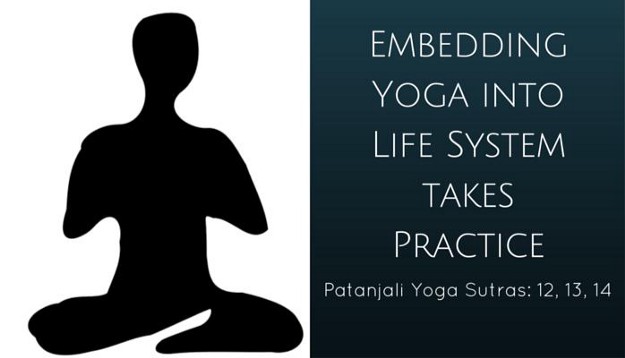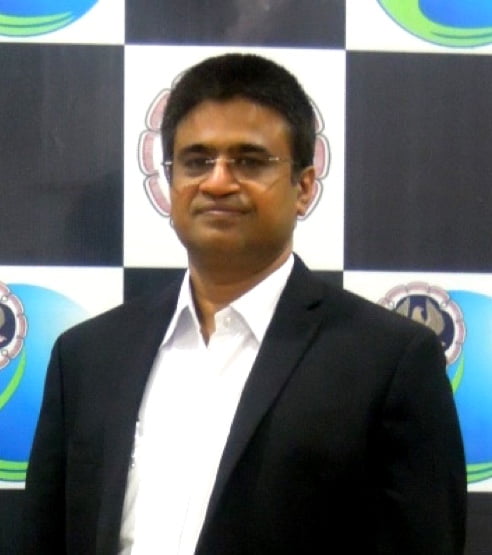In the previous posts, we have discussed all the five types of vrittis, responsible for disturbing the tranquility of mind. Recollecting the learnings till now, we have understood how Yoga helps one to get rid of the uninterrupted thought waves. In this post, we will talk about how one can control the vrittis through a disciplined and a consistent Yogic practice or abhyasa.
अभ्यासवैराग्याभ्यां तन्निरोधः॥१२॥
Abhyāsavairāgyābhyāṁ tannirodhaḥ ||12||
Abhyasa is a Sanskrit term which means devout and persistent practice. A dedicated practice of yoga helps an individual to remain calm and serene, in spite of the constant pounding of thought waves. The yogic practice affects the mind in two ways, one reducing the number of thoughts and the other subduing the response to the same. A continual practice slows down the frequency of thoughts and weakens the firmly rooted thought waves. It gradually establishes a clear and disciplined state of mind which is required to be maintained by the practitioner.
We will use some terms of the software industry to understand this concept better. The continuous flow of thought waves is a feature of individual’s mind and not a bug. Reacting to those thoughts and having emotions & mood swings is also an intrinsic feature. The third feature is that the individual can not have any single emotion or a mood or state of mind continuously for a longer period. No matter how grave the sorrow is, every individual is programmed to overcome the grief, align himself with the reality and move on in life. All these are innate features about which these scriptures seem to have done a lot of research.
Yogic practice is performed to regulate and bring these features under the control of the individual. Here, it is important to note that each individual in himself is a unique and custom made instrument with these default inbuilt characteristics. There is no standard quantified practice schedule. The required level of practice, the duration and the intensity, everything will be a proprietary formula for each individual. The individual has to find it out himself through measuring his own level of practice and the benefit gained. He can get help from the ancient scriptures or a guru, but he will have to modify and tweak any given or suggested recipe and bring up his own unique concoction. Thus, it is clear that there are no set standards or time frame for the abhyasa or practice, except for dedication and consistency. Once the practice has been mastered by the individual, the methods adopted for practice become irrelevant.
तत्र स्थितौ यत्नोऽभ्यासः॥१३॥
Tatra sthitau yatno’bhyāsaḥ ||13||
The above aphorism recommends every individual to abide in that undisturbed mental state which is attained through a regular practice of yoga. Remaining in that state, he should keep meditating regularly in order to firmly establish the practice in his soul or eternal being through regulating the mind. The recurring thought waves no longer distract the individual once the practice has been well established.
The most important thing to be maintained here is regularity in the practice. Some practitioners of yoga interrupt the regularity by taking repeated breaks from their daily practice. They discontinue the practice for weeks and even months before the same is firmly embedded in their life style. Without consistency, the level of practice attained gradually vanes from the mind. As a result, the practitioner has to begin back from square one, every single time he leaves the practice for an extended period of time.
Having control over the ever occurring vrittis is not easy a task. It takes time, patience and dedication to uproot the established thought patterns and get rid of them. For this reason, the above sutra entails performing a regular practice, which helps an individual to slowly gain control over different thought waves. Performing abhyasa consistently establishes the practice firmly into the mind. In addition, a consistent practice has also been suggested in order to reduce the speed and the number of thoughts coming in. It lets an individual to subdue and reduce the intensity of the reactions and move on quickly without acting, as he is normally used to.
The duration of practice however has not been specified in the sutras as it depends on each individual. It should be defined by the individual himself when the state of control over the thought waves is established and can be attained with ease whenever he wants to. The final stage to be achieved by the practice is quantified in the later sutras. But it does not mention any optimum time frame to achieve that state. Thus, the practice is to be done by each individual till he achieves the required parameters.
The above sutra suggests every individual to hold on to the undisturbed state of mind attained through devout practice. The extent and intensity of practice however is custom and proprietary. It varies for each person depending upon his nature, samskaras and gunas. Regular practice thus forms an integral part of yoga, to embed such nature and clarity of mind in a person for lifetime and even beyond. We will discuss in detail on these phrases in the upcoming posts.
स तु दीर्घकालनैरन्तर्यसत्कारासेवितो दृढभूमिः॥१४॥
Sa tu dīrghakālanairantaryasatkārāsevito dṛḍhabhūmiḥ||14||
As said earlier, the effect of this practice should result in the art of control of the thought waves becoming entrenched. Borrowing again from the software industry, the practice should become embedded so deeply inside the individual that it remains with him for his entire life, to be passed on to the next incarnation. The whole system of yoga has to do with the core being of individual, reaching beyond the physical body and even mind.
The Human body is first an embryo, created by the fusion of one sperm out of a million and an egg under conducive atmosphere. That fusion creates our body and when soul or atman fuses into the physical body, it creates the individual. If the second fusion does not happen, then we get what is called a fully formed but lifeless child. Genetic engineering has been able to identify the reason for blonde hair or the blue eyes and other such physical traits. Similarly, there are intrinsic habits and traits in every individual that are referred to as Samskaras and gunas in the following sutras.
The goal of abhyasa is to deeply embed the habit of control over the thoughts. It aims to turn this habit into the essential nature of the practitioner. With a committed practice, it is possible to physically transfer this habit into the biological offspring which is carried by the soul to the next incarnation. This is the reason why above sutras repeatedly suggest a devoted practice so as to embed it into the being of the person. Such embedding is evident all around us in nature. The embedded trait is so powerful that it can remain dormant for years or centuries and still retain the potent energy to show the true trait when the favorable atmosphere is made available. It is only after attaining this level of practice that an individual can say he has experienced the yogic states.
For instance, a guava seed taken from India, exported to America and planted there, will always grow into a guava tree and not give oranges even after centuries. Science, which began with grafting and hybrid cultivation is now cloning individuals from their DNA. In the same way, Yogic Habits are recommended to be practiced till we are able to get the traits embedded into our DNA. This is what a consistent abhyasa or practice can make possible and even more. The steps to achieve all that are vividly described as we go to the subsequent Sutras.
It is mentioned in the upanishads that the embedded trait in DNA can be potent for up to seven generations. If an individual practices yoga from childhood and adds these positive traits to his DNA during his life, he is likely to pass on the trait as Samskar to all or any of the 7 biological generations of his.
More about the ways of regulating thoughts and Practicing yoga in the next post.

